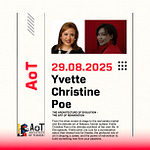Architecture has always been more than drawings or buildings—it’s about shaping trust, culture, and our shared future. But in today’s age of global migration, digital platforms, and rapid climate urgency, architects are called to step into an even larger role: as guardians of truth, cultural voice, and resilience.
In this episode of Architect of Things (AoT), I sat down with Regina Gonthier, President of the International Union of Architects (UIA), whose leadership has influenced global architectural practice for decades. Regina brings experience from teaching at ETH Zurich, revising Swiss competition regulations, chairing national councils, and representing architects at the UN Climate Change Conference (COP29), where she called for “architecture in solidarity for a green world.”
Our conversation explored how architects today must rise above buildings to safeguard people, cultures, and futures.
Architecture as Confronting Reality
Where others describe architecture through metaphors of storytelling, Regina offers a sharper lens: “Architecture is not telling stories—it is confronting reality.”
Unlike narratives that can be polished or platforms that can distort, the built environment is immediate. It is lived, embodied, and remembered. A building cannot be falsified—it confronts people directly, through well-being, identity, and belonging. And in that lived encounter lies truth.
Protecting Identity in a Globalized World
As cities absorb migration and globalization accelerates, architecture risks drifting toward sameness. Regina insists: “We need diversity. Imagine how dull the world would be if everything was homogeneous.”
Protecting cultural identity, she argues, is not nostalgia—it is an act of reinterpretation. By weaving together tradition, local craft, and innovation, architecture keeps communities from being erased. Diversity in the built environment is not ornamental; it is essential to dignity.
Ethics and Overlooked Communities
When asked how architects can ensure overlooked communities are represented, Regina was clear: “The respect of the memory of a place, its inhabitants, and culture is a non-negotiable must.”
Her stance acknowledges a truth many avoid: bias exists not only in institutions but in emerging technologies. Algorithms are not neutral. Digital tools can render entire groups invisible if architects don’t question their outputs. Regina calls for architects to lead with ethics, ensuring that dignity is never sacrificed for efficiency.
Public Interest Architecture in a Time of Crisis
Architecture is inherently a discipline of public interest. But what happens when governments fall short in addressing climate urgency?
Regina’s answer: responsibility doesn’t vanish—it shifts. “As architects, we must convince our clients for sustainable solutions.” Even in a lagging policy environment, architects can make resilience not only possible but profitable, future-proof, and ethical.
AI, Trust, and the Future
We also spoke about the rise of AI in design. Regina cautions that without accountability, AI risks erasing cultural voices and amplifying biases. “Architecture is about how we want to live together,” she emphasizes. Technology must remain a tool—not a substitute—for human judgment.
Why This Matters Across Generations
For me, this conversation echoed lessons from my time at the Taliesin Fellowship, where architects, artists, children, and elders lived, learned, and worked side by side. It revealed that architecture is not bound by age or discipline—it is a cultural practice that thrives when generations and perspectives intersect.
That spirit of intergenerational dialogue is what I aim to bring to AoT: pluralistic conversations where leaders like Regina resonate with the youngest students and the most seasoned practitioners alike.
A Call to Courage and Optimism
Despite the challenges, Regina reminds us that architects are by nature optimists: “We create in an optimistic way the better solution for a given problem. Challenges are inspiring and promote solutions.”
🎧 Listen now to this episode of Architect of Things. Together, let’s design not just buildings—but trust, resilience, and belonging across generations.
📌 What You Can Do
Architects & designers: Design beyond efficiency. Protect identity, dignity, and cultural truth in every project.
Educators: Teach ethics and intergenerational responsibility alongside tools and techniques.
Professional institutes: Update codes of ethics to confront misinformation, disinformation, and AI bias in the digital era.
Everyone: Value architecture not just as a service, but as a cultural act that safeguards truth and belonging.
👉 This is how we shape a greener, more truthful, and pluralistic future—together.











